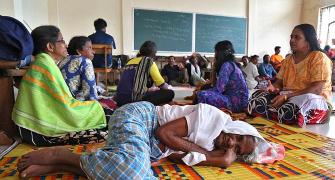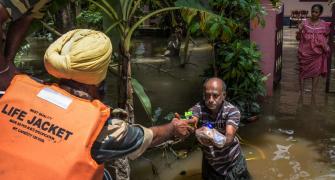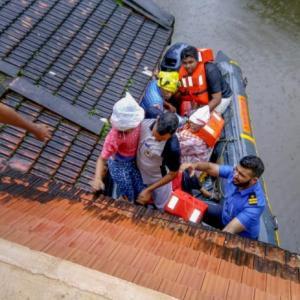With operations to rescue stranded people from flood-affected areas nearing a close, the Kerala government on Wednesday turned its attention to cleaning of houses and public places which were damaged in the unprecedented rains which ravaged the state.

According to the Disaster Management State Control room, 231 people have lost their lives and 32 are missing in flood-related incidents since August 8.
Nearly 14.5 lakh people from 3.91 lakh families are still in about 3,879 relief camps across the state.
The largest number of people in relief camps was in the worst-affected Ernakulam district with a total of 5.32 lakh in 850 camps.
Though water has started receding in some places, areas near the river banks and Kuttanand in Alapuzha continue to be under water.

More than 3,000 squads under health and local self-government departments have started the process of cleaning houses and public places, official sources said.
Chief Minister Pinarayi Vijayan has said that most of the stranded people have been rescued and searches would continue in isolated houses to find if any persons are trapped.
Indian Air Force personnel rescued 15 people, including 11, who were trapped in an areas cut off due to landslides in Nelliyampathy in Palakkad district on Tuesday.
Officials said about 12,000 houses were cleaned on Tuesday and about 12,000 volunteers were on the field.
As people left camps, many found mud and slush up to six feet level in front of their houses and interiors.
Fridges, television sets and other electronic equipment were all lying upside down in the turbid waters.
Many children lost their books and certificates. Many people lost their Aadhaar and ration cards.

"We will have to start afresh. Right from the beginning," a woman lamented.
Another major problem being faced by those returning home is the severe drinking water shortage as the wells are contaminated with muddy water.
Piped water supply is yet to begin in many places.
Volunteers engaged in relief work in rain-hit regions in Kochi say houses, flats and shops affected by the floods resembled a 'battlefield' and it is 'a very big challenge' to restore them.
MLAs Hibi Eden and M Swaraj said volunteers and officials could not open many homes as they were filled with carpet of slush and debris dumped by the floods.
"The houses hit by floods look like battlefields. It will take some time for the people to rebuild their lives," Eden, a Congress MLA, said while taking part in rehabilitation activities at Cheranellore Panchayat which falls under his Ernakulam constituency.
"Cleaning of flood-hit houses, shops and flats is a very big challenge because you are welcomed there by knee-deep slush and reptiles including venomous snakes," Swaraj, a Communist Party of India-Marxist MLA representing Thrippunithura constituency, said.
He has been involved in cleaning work with party colleagues and volunteers in nearby Aluva, one of the worst affected areas situated on the bank of Periyar river.
Eden said the house of a poor man in Cheranellore collapsed when its door was opened for cleaning.

Many of the houses of the poor are not safe as the floods have weakened their walls and roofs, he added.
He also said carcasses of animals like cows, goats and dogs killed in the floods were also lying unattended, posing health risks.
Nearly 3,000 carcasses of cattle were buried across the state on Tuesday, officials said.
In a show of unity, a group of Muslim youths cleaned up temples in Malappuram and Wayanad districts.
The state government has sought a relief package of Rs 2,600 crore under the MNREGS scheme and also under centrally-sponsored programmes.
The chief minister informed Prime Minister Narendra Modi during his visit to the flood-affected areas on Sunday Kerala had suffered a loss of Rs 19,512 crore as per preliminary estimates and only after water recedes the exact loss and damage could be assessed.

The state had also sought an immediate relief of Rs 2,000 crore to take up relief works and the Centre sanctioned Rs 500 crore to the state.
The Chief Minister’s Disaster Relief Fund had received donations to the tune of Rs 309 crore till Tuesday evening through online and deposits in the special SBI account.
The United Arab Emirates government also offered an amount of $100 million (about Rs 700 crore) for the state’s reconstruction.
The toll rose to 231 on Tuesday in one of the worst floods witnessed in the last century in Kerala with the recovery of eight more bodies from different parts a fortnight after a murderous monsoon rampaged through the state in its second spell that began on August 8.

Meanwhile, a team of 40 Border Security Force personnel has fanned out in Kerala's Thrissur district for post-disaster rescue and sanitisation operations even as the force has rescued over 500 people from the flood affected areas till now, a senior official said on Wednesday.
The BSF has its 162nd battalion based in Thrissur and all its staff has been deployed for the relief and rescue operations since the disaster struck, he said.
A special team of 40 personnel have been sent to multiple locations in the district so that they can help the local administration in launching operations to clear submerged areas, remove debris and bodies in order to restore normalcy and help the residents in rehabilitation, the official said.

This team has been provided necessary equipment and vehicles to even reach the remote corners of the district under the directions of the local administration, he said.
More than 500 people have been rescued from various marooned areas of this district by the force till now, he said.
Over 12,000 litres of drinking water has also been dispatched to the affected areas as the next phase of bringing back and putting together the lives of the displaced is a concern.
About 15 response teams of the border guarding force are also running shelters, food camps and medical assistance facilities or the affected people, he said.

Mosque offers shelter to Hindus
With a mosque opening its portals to distressed Hindus and Muslims cleaning temples, the murderous monsoon seems to have washed away the barriers of religious differences.
Amid the distress triggered by the floods, a mosque in northern Malappuram, one of the worst-hit districts, has offered shelter to 17 displaced Hindu families, including women, children and the elderly.
The Juma Masjid, located at Akampadam in Chaliyar village, has virtually turned a relief camp since the second spell of rains started to devastate the northern districts on August 8.
Cutting across religion and caste, the displaced people were given space to sleep inside the mosque, provided food prepared at its canteen and given rice, pulses and other essential materials when they returned home.
Most of the 78 people, who were given shelter at the Juma Masjid, were Hindus, Chaliyar village panchayat chief P T Usman said.
"There were 26 families who had sought refuge in the mosque, a majority of them Hindus. Though we opened the relief camp at the mosque on August 8, the activities started in full swing only after August 14, following a series of landslides that rocked the district," he told PTI.
The Hindu families returned two days ago as water receded from their submerged homes, Usman said.
"The rest returned home after taking part in the observance of Bakrid today," he added.
Meanwhile, two groups of Muslim men had no hesitation in cleaning Hindu shrines in Wayanad and Malappuram districts.
A Vishnu temple at Venniyode in Wayanad and a shrine dedicated to Lord Ayyappa at Mannarkkad in Malappuram, inundated due to the floods, were cleaned by them.
Many shared the photos of the Muslim men cleaning the temples on social media.
NASA estimates monsoon rains behind Kerala floods
National Aeronautics and Space Administration has released a video using satellite data that provides an estimate of rainfall and shows the spread of the resulting severe flooding in Kerala, and parts of Karnataka.
The summer monsoon is a regular feature this time of year in India, and it can bring heavy rains to the region.
However, periodically areas of low pressure can form within the general monsoon trough and bring even more rain.
Although the extreme Himalayan topography is much more well-known, another contributing factor to the heavy rains along the southwest coast of India is the Western Ghats, NASA said in a statement.
Though much smaller than the Himalayas, this mountain range runs parallel to the West Coast of India with many peaks over 2,000 metres.
As a result, the Western Ghats are well positioned to enhance rainfall along the West Coast of India as they intercept the moisture laden air being drawn in off the warm waters of the northern Indian Ocean and Arabian Sea as part of the southwest monsoon circulation.
The Integrated Multi-satellitE Retrievals for GPM (IMERG) is used to estimate precipitation from a combination of passive microwave sensors, including microwave sensor and infrared data.
GPM is the Global Precipitation Measurement mission core satellite. GPM is a joint mission between NASA and the Japan Aerospace Agency, JAXA.
Rainfall accumulations from August 13 to 20, 2018 showed two bands of heavy rain across India.
The first band appeared much broader and extends across the northern part of the peninsula with weekly rainfall totals ranging from over 5 inches towards the western half of the peninsula to as much as 14 inches over parts of the eastern half towards the Bay of Bengal.
The first band is associated with the general monsoon circulation.
The second band appeared more concentrated and intense and is closely aligned with the southwest coast of India and the Western Ghats where onshore flow was enhanced by an area of low pressure embedded within the general monsoon.
Weekly rainfall totals in this band are generally over 10 inches with embedded areas exceeding 16 inches.
The maximum estimated value from IMERG in this band was 18.5 inches.










